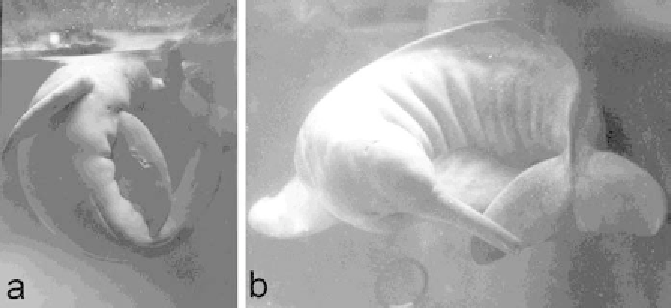Biology Reference
In-Depth Information
articulations. The results for each of these regions may include a small amount of mobility
afforded by thoracic articulations. Moreover, flexibility in the cervical region could
presumably include some movement at the atlanto-occipital joint, although this too is
presumed to be rather minimal due the ovoid and transversely broad shape of this joint.
Measurements were obtained from captured still dorsal images as follows. First, a straight
line was drawn across the longitudinal (i.e., midline) body axis and measuring the maximum
divergence of the neck and torso from this line (recorded in degrees). A line through the
thoracic region (Figure 3a) was selected as the midline axis, since this is the least mobile
region due to costal articulations. The thoracic line was established as follows: a line was
drawn across the flippers, specifically where their anterior edge meets the body wall. The line
perpendicular to this line (A-B, Figure 3b) was used to estimate the central line of the thoracic
region. Flexion occurring in the cervical and atlanto-occipital regions was estimated by
measuring the angle between A-B and a line drawn through the rostrum (a-b, Figure 3b). To
estimate the degree of bending in the anterior torso region, a line was drawn through the
dorsal ridge (c-d, Figure 3b). The angle between A-B and c-d was interpreted as the angle of
lateral flexion formed in the anterior torso region. Finally, a line was drawn longitudinally
through the center of the flukes, in line with the peduncle ridge (e-f, Figure 3b). The angle
formed by c-d and e-f was interpreted as the angle of lateral flexion in the posterior torso
region.
R
ANGE OF
M
OBILITY
Table 1 shows the ranges of lateral flexion observed in each presumptive region of the
vertebral column as measured from captured images. Also included are ranges for training
behaviors versus feeding sessions. The most acute angles, indicating the highest degrees of
flexion, are seen in the torso region. The greatest magnitude of lateral flexion is observed in
the posterior torso region (about 125 degrees), although the anterior torso region itself has a
high degree of lateral flexibility (as much as 95 degrees). Cervical flexibility was more
limited, reaching a maximum of 83.8 degrees.
Figure 4. A trained river dolphin touches its rostrum to its tail (a & b). (photographs by TD Smith).


Search WWH ::

Custom Search